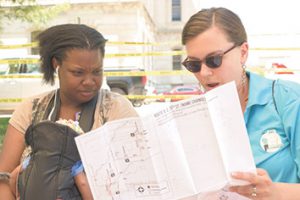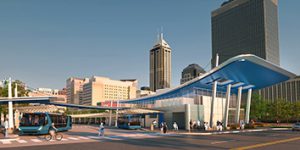IndyGo chooses winners in Red Line design contest
All three winning designs for the route’s stations were crafted by professionals, but the transit service hasn’t decided how closely the final stations might reflect the renderings.
All three winning designs for the route’s stations were crafted by professionals, but the transit service hasn’t decided how closely the final stations might reflect the renderings.
IndyGo is hosting four public meetings this month to share updates and answer questions about the 35-mile bus rapid transit line proposed from Westfield to Greenwood.
While they wait for $75 million in federal funding to come through, transit officials are trying to ensure the first phase of the Red Line is shovel-ready.

For the first weekday morning commute at the Julia M. Carson Transit Center, IndyGo workers fanned out to help riders get their bearings. Traffic lights didn’t always cooperate.

In a contest, college students created tools to find links between crime and mass transit and to encourage use of both IndyGo and the Indiana Pacers Bikeshare service.

Teams of IndyGo volunteers, called “transit ambassadors,” are on foot at bus stops around the city, spreading the word about big changes that will affect all 31 of the system’s routes.
More than 700 bus stop changes will be made throughout Marion County to prepare for the June 26 opening and 31 related route changes. Updates include new and eliminated stops, and stop relocations.

Business leaders in charge of the advocacy work said Tuesday morning they expect to launch a “targeted” advertising and informational campaign by highlighting the possible benefits of expanded mass transit to a wide variety of groups.

Former U.S. Rep. Julia Carson was instrumental in securing funding for an Indianapolis public transportation hub.
The debate over whether Indianapolis residents should be able to vote this November on an income tax increase to pay for improved public transportation will soon heat up.
The first phase of the $198 million Red Line is slated to run from just north of Broad Ripple to the University of Indianapolis.
IndyGo has received the last of 21 fully electric buses. Those buses, equipped with lithium-ion batteries, can travel up to 130 miles on a single charge.
Construction work on the IndyGo transit center, which is expected to become a hub for most of Indianapolis’ bus lines, has been delayed by seven months. The project’s estimated cost has risen from $20 million to $26.5 million.
Officials say the first phase of a rapid transit line that should eventually connect Westfield to Greenwood won’t be delayed even though the Indianapolis region missed out on a share of $84 million in state funding from the Regional Cities Initiative.

The team charged with designing and engineering downtown’s $20 million transit center—which has begun to emerge south of Washington Street between Delaware and Alabama streets—took on three core challenges.
A fund for public transportation could be debated before the House Ways and Means Committee after Rep. Randy Truitt filed a bill that would provide about $20 million more per year than Gov. Mike Pence proposed.

IndyGo isn’t threatening to eliminate routes, but it is trying to craft a policy to guide it through landmark changes: next year’s opening of the $20 million Downtown Transit Center and, possibly, the passage of a referendum in favor of a regional rapid-transit system.
Two reverse-commute routes will serve the north Plainfield and Whitestown warehouse districts, taking workers from Indianapolis to major employers like Amazon, GNC, Ingram Micro and Tempur Sealy.
An Indianapolis software startup that hopes to win contracts from public-transit agencies across the country is protesting a no-bid deal by IndyGo.
Starting this fall, IndyGo will have digital signs at downtown stops that show when the next bus is arriving, and passengers throughout the city will be able to check their phones or home computers for next-bus information.